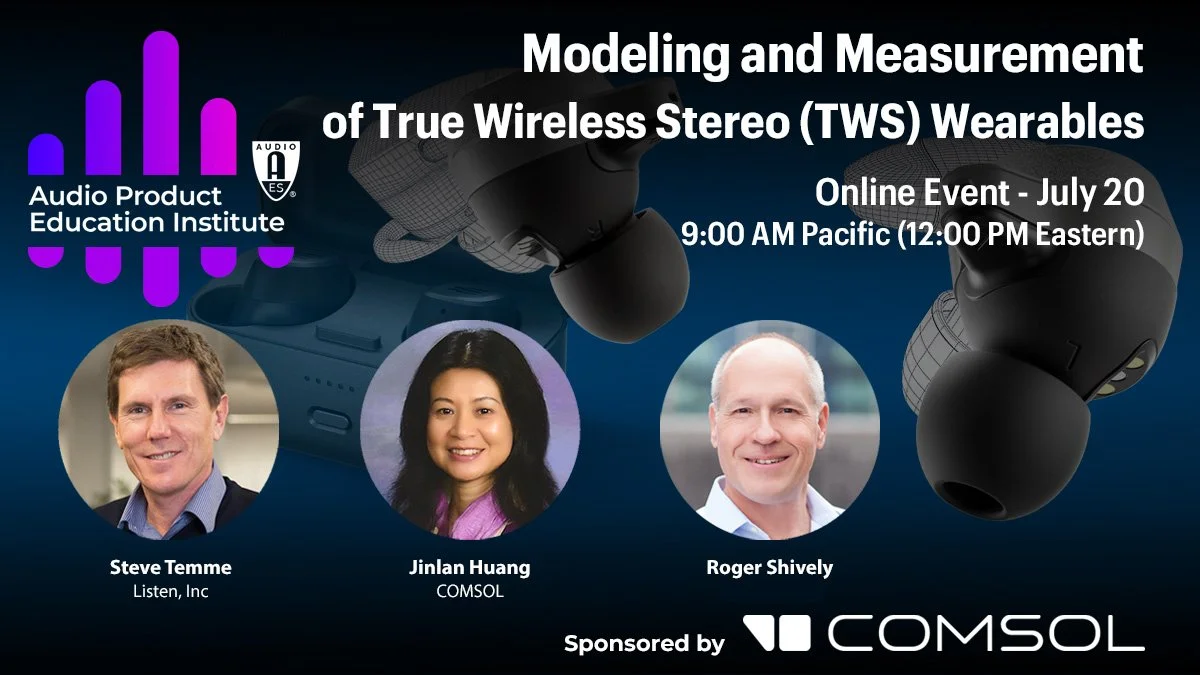"Modeling and Measurement of True Wireless Stereo (TWS) Wearables" Featuring Roger Shively
"Modeling and Measurement of
True Wireless Stereo (TWS) Wearables"
July 20, 2021 | 12-2pm Eastern Standard Time
This Audio Product Education Institute webinar, expands on the topic of modeling, simulation and measurements in audio product development and the design process. Exploring the specifics of one of the newest and fastest-growing consumer electronics categories, combining the most cutting-edge technologies, the webinar intends to showcase how these processes fit in the design cycle.
Strong consumer demands have driven true wireless stereo (TWS) devices to become the most dominant category of product shipments in the past few years. The increased demand drove down selling prices, and with the market’s low barrier to entry, the mature supply chain resulted in better devices at lower price points, and vast shipments flooded the market in a short period of time. TWS earbuds are one of many wearable devices and are popular for pairing with smart watches, phones, and laptops. The voice sound quality of the many different products varies. This session will look at the subjective evaluation, acoustic measurement, and simulation of some typical TWS earbuds many of us use every day.
View this online webinar right now on demand here.
More information about this online event and future APEI, now known as the Audio Product Development Alliance (APDA), webinars can be found on their website here.
Session 1: Voice Sound Quality Assessment Over TWS Earbuds,
Roger Shively, Shively Acoustics
Presented and discussed will be the results of subjective evaluations of the voice quality received via a number of TWS earbuds. Audio examples of some devices in mostly live and mostly dead acoustic environments will be played and corresponding frequency response data will be shown. And, the description and results of listening tests for these devices will be shared.
Check out our management team here.
Session 2: Testing the Audio Performance of Hearables,
Steve Temme, Listen, Inc.
Hearables are notoriously challenging to test. They have various interfaces ranging from hardwired to wireless (e.g. Bluetooth) and may contain much signal processing, both on the record side (e.g. beamforming, background noise filtering, voice activity detection, and on the playback side (e.g. loudness, compression, equalization, and active noise cancellation). This means that their characteristics change according to ‘real world’ conditions such as their physical environment and background noises. Some even have wake word detection, e.g. “Hey Siri”. Furthermore, their multifunctional nature means that there are many aspects of the device that may need to be tested, ranging from voice recognition to music playback or even operation as a telephone handset or hearing aid. Due to their complex non-linear use cases, these devices often need to be tested at different levels and in different environmental conditions, for example with background noise, different signals, etc. Presented will be some ways to acoustically measure these complex devices.
Check out Listen, Inc’s website here.
Session 3: Using Simulation in the Design of Hearable and In-Ear Audio Devices,
Jinlan Huang, COMSOL
In this presentation, we will discuss how simulation can be used to help the design of hearable and in-ear audio devices such as hearing aids, earbuds, headphones, and headsets. We will look at examples that investigate the acoustics of an occluded human ear canal, study the effect of unwanted leaks or on-purpose open solutions in an earbud setup, or analyze the acoustics of a generic head and torso simulator to get the head-related transfer function (HRTF) and the mouth-to-ear transfer function. Other examples showcase how to model a miniature loudspeaker (a balanced armature receiver) using either a full detailed electro-vibroacoustic finite element analysis or a lumped representation, and how to study the interaction between the transducer and the rest of the system.
Check out COMSOL’s website here.
The mission of the APEI Automotive Pillar is to explore and explain the practical approach and development of all the products that are conceived, planned, designed, and implemented in automotive car audio. They plan to hold an online session for Automotive Audio every month, so stay tuned for our upcoming sessions in 2021.
Be sure to leave a comment below with your thoughts on this webinar!




